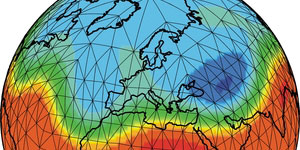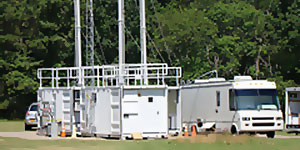Atmospheric Radiation Measurement (ARM) Climate Research Facility

The ARM Climate Research Facility,
a DOE scientific user facility, provides the climate research community
with strategically located in situ and remote sensing observatories
designed to improve the understanding and representation, in climate and
earth system models, of clouds and aerosols as well as their
interactions and coupling with the Earth’s surface. BNL is actively
involved in several ARM facilities and in a variety of ARM field
studies.

External Data Center
The ARM External Data Center (XDC) identifies sources and acquires data, called "external data", to augment the data generated within the program. The scientific need and the priorities for acquiring, processing and archiving the external data-streams are established by the science working groups and considers such factors as availability and accessibility in other archives, acquisition cost, and ease of use of the native data-format.

Cloud Life Cycle Infrastructure
The cloud life cycle infrastructure group at BNL is responsible for the development and production of cloud-related datasets. A major focus of these production activities is the retrieval of geophysical properties from millimeter cloud radar observations and routine atmospheric soundings. BNL also provides mentorships for ARM instruments and datastreams.

MAOS
The Mobile Aerosol Observing System (MAOS) is a platform and instrument suite for conducting in-situ measurements of aerosols and their precursors. MAOS is contained in two 20’ SeaTainers customized to provide a sheltered laboratory environment for operators and instruments operating under harsh conditions.
Field Studies
MAGIC
MAGIC studies low marine boundary layer clouds with radar and other instrumentation on two ships making regular transects between Los Angeles and Hawaii. The objective is to improve the representation of the stratocumulus-to-cumulus transition.
TCAP
The Two-Column Aerosol Program is designed to provide a detailed set of observations to quantify aerosol properties, radiation, and cloud characteristics at a location subject to both clear and cloudy conditions, and clean and polluted conditions.
Biomass Burns
The Biomass Burning Observation Project (BBOP) conducts aircraft observations to study the near-field evolution of changes in the properties of aerosols generated in biomass burning events which release soot, organic aerosols and heat-trapping gases that perturb the Earth's climate.
Aerosol Life Cycle IOP
The goals of this program are to conduct intensive aerosol observations in a region exposed to anthropogenic, biogenic, and marine emissions with atmospheric processing times depending on air mass trajectories and time of day.
RACORO
RACORO is a first-of-a-kind, extended-term cloud aircraft campaign conducted to obtain an in situ statistical characterization of continental boundary-layer clouds.
MC3E
The Midlatitude Continental Convective Cloud Experiment (MC3E) was conducted in south-central Oklahoma to provide the most complete characterization of convective cloud systems and their environment ever obtained.


